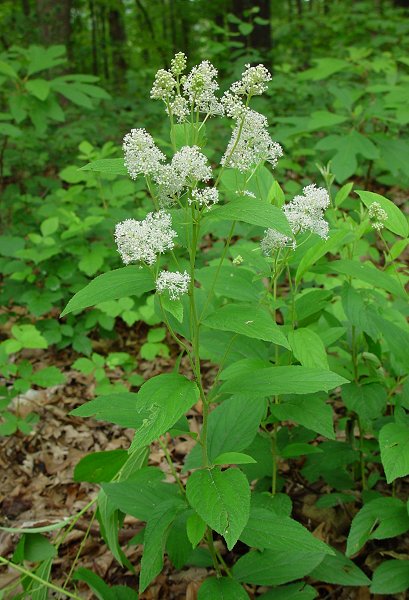Ceanothus americanus L.
New Jersey Tea

Native
CC = 7
CW = 5
MOC = 76
© DETenaglia
Ceanothus americanus L.New Jersey Tea | |
 |
Native CC = 7 CW = 5 MOC = 76 |
© DETenaglia |
|
Family - Rhamnaceae Habit - Shrubs to 1 m, with ascending branches. Stems - Erect with ascending branches, woody, multiple from base, densely pubescent with a mix of longer and shorter hairs above, minutely hairy to glabrous below.
Leaves - Alternate, simple, petiolate. Petiole to 6 mm long, densely pubescent. Blades 1-8 cm long, 0.5-5.0 cm wide, ovate to oblong-ovate, rounded or shallowly cordate at base, bluntly or sharply pointed, sharply and finely toothed, the upper surface rugose and sparsely to moderately pubescent with short, somewhat cobwebby hairs, rarely glabrous, the undersurface moderately to densely short-hairy, rarely glabrous.
Inflorescence - Terminal panicles on short branchlets that are axillary on the main branchlets of the current-year's growth, relatively long-stalked. Inflorescence stalks to 6 cm long, densely pubescent, longer than subtending leaf. Panicle to 4 cm, hemispheric to cylindric. Pedicels white, glabrous, expanded at apex below calyx, to 6 mm.
Flowers - Perfect. Hypanthium small, 3-4 mm in diameter at fruiting. Sepals 5, 0.5-1.0 mm long, oblong, somewhat concave and the tips incurved at flowering. Petals 5, 1.5-2.5 mm long, tapered to long stalked bases, white. Stamens 5, opposite the petals, erect and exserted. Filaments to 1 mm long, whitish with a purple tinge, glabrous. Anthers purplish. Ovary 3-locular, shallowly 3-lobed at the tip, the style 3-branched toward the tip. Ovary surrounded by a purple nectary ring, 3-locular.
Fruits - Capsulelike, modified drupes, with 3 lobes and 3 stones, 4-5 mm broad, the outer surface thin, leathery, black, not glaucous, the stones dehiscing explosively at maturity, tearing open the outer fruit layers and expelling the seeds. Seeds 1.5-2.0 mm long, more or less obovate in outline, somewhat anglar, the surface smooth, reddish brown to brown, shiny.
Flowering - May - November. Habitat - Prairies, glades, open woods, thickets, railroads. Origin - Native to the U.S. Lookalikes - Ceanothus herbaceus. Other info. - This species is found across Missouri, the eastern half of the U.S., and parts of Canada. In Missouri it is neither uncommon nor particularly abundant. It is reasonably easy to identify, with puffy white inflorescences and textured, alternate leaves. The fruits are unmistakable. Various authors have subdivided the species into three varieties, two of which occur in Missouri. Variety pitcheri T.&G. is the more common, appearing as described above. A rare variety, var. intermedius (Pursh) K. Koch, has smaller leaves which are glabrous above and only slightly pubescent below. This latter variety is only found in a couple of counties in the eastern portion of the state. However, Yatskievych and others have suggested that varietal recognition be deferred pending more research on the genus. Photographs taken at the James C. McCormack Conservation Area, Holt County, MO., 6-30-00, and off Hwy 106, Shannon County, MO., 6-6-03 (DETenaglia); also at Onondaga Cave State Park, Crawford County, MO, 6-12-2014, Little Lost Creek Conservation Area, Warren County, MO, 7-7-2020, and Gist Ranch Conservation Area, Texas County, MO, 6-9-2022 (SRTurner). |